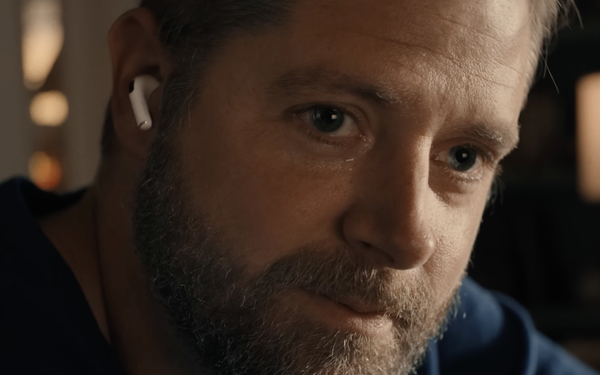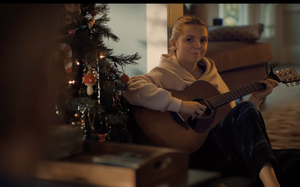
Apple’s latest
Christmas ad, “Heartstrings” is aptly named. It delicately plucks at the human ticker, (well, I cried) without being overly
sentimental or treacly.
Instead, it humanizes tech while delivering something new: a carefully tinkered-with soundscape that’s inspired.
We’re used to watching commercials
for the visuals, with the audio considered sometimes as an add-on.
Here it’s key to the story, which is genius in a spot about improving your hearing.
Created by TBWA/Media Arts
Lab, the spot opens on a Christmas morning, with a teen girl unwrapping her gift: a guitar. She starts to play, and we see flashbacks of her as a baby, toddler and tween with an obvious gift for
strumming, starting with when she got her first little yellow plastic ax.
advertisement
advertisement
But the commercial is really about her dad, who sits on a sofa nearby, walled off from the moment and its beauty.
It becomes clear that we’re hearing what he hears: disconcertingly muffled sounds.
His wife encourages him to put in his Air Pods, which he does while adjusting the sound on his
iPhone. Now it’s clear as a bell.
And it literally is music to the ears. His daughter is playing and singing to “Our House,” by Crosby, Stills, Nash and Young, a
touching, perfect boomer song for a demo dealing with increasing hearing loss. (Although this dad looks more Gen X.)
Enveloped by her beautiful singing voice and artful playing, we then
revisit skillfully shot and edited visual milestones in her life, this time hearing what the little girl is saying along the way.
This beautifully human ad was directed by Henry-Alex
Rubin.
Academy Award winner Paul N. J. Ottosson was the sound designer who expertly distilled the different modulations, frequencies and volume that viscerally capture the frustrating
experience of moderate hearing loss.
The audio focus is on a poetic part of the Graham Nash song. (He was writing about his time with Joni Mitchell.) The lyrics are, “Our house is
a very, very, very fine house, with two cats in the yard. Life used to be so hard, now everything is easy ‘cause of you.”

It's a heartwarming song, yes, but it also obliquely alludes to the
father’s new ease of life with the Air Pod Pro 2, when used as a hearing aid for people with mild-to-moderate hearing loss. (The FDA approved Apple ear pods for over-the-counter purchase in
September.)
“Heartstrings” broke in time for the International Day of Persons with Disabilities on Dec. 3. It's the latest in a breakthrough series of Apple ads that promote
disability representation in advertising. This one admirably integrates the disability message with a fresh but emotional Christmas story, and the result is exactly right.
So I was
surprised to see the reaction of conservative media and Xers, hundreds of whom flooded the net with headlines like, “Apple Releases Shocking Pro-Family Christmas Ad.” That one was
the work of the National Review, a tongue-in-cheek attempt to celebrate the ad’s non-wokeness.
Many outlets registered that same surprise to get an Apple ad that’s not
“woke.”
This was head-scratching. For me, woke means “awakened” -- to the changing demographics of the country, to the progress made in acceptance for gay marriage and
trans folks and people of many races and religions. This one showed understanding of, and compassion for, people with hearing disabilities.
So do those who hate “woke”
consider the spot “pro-family” because it shows an all-white (aka “normal?”) family with an unfortunately distant dad?
Or do they also want to stick it to CEO Tim Cook,
who recently, along with an array of tech leaders, posted congratulations on X to President Trump for his election win?
Clearly, Cook wants to maintain a good relationship with the
president-elect. Years before Elon became an almost-permanent houseguest at Mar-a-Lago, Trump praised Cook by saying “he’s the only one who calls me directly.” As a result of
those talks, the Cupertino-based company did manage to get government exemptions during Trump's first term.
What will happen now is uncertain.
This holiday spot will run globally
across broadcast, digital platforms, and social media.
Wherever you are in the world, it gets an A for sound, design, and writing, and showing a way to make tech -- as well as our collective
human heartstrings -- universally accessible.